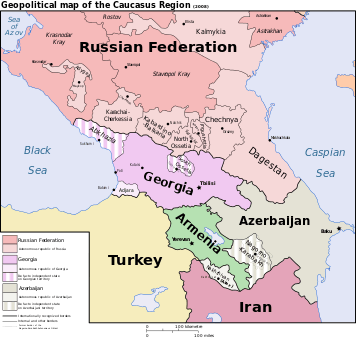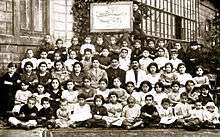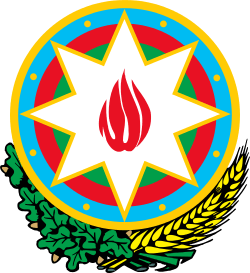Bahá'í Faith in Azerbaijan
| Part of a series on |
| Bahá'í Faith |
|---|
 |
| Central figures |
| Key scripture |
| Institutions |
| History |
| People |
| Holy sites |
|
| Other topics |
|
The Bahá'í Faith in Azerbaijan crosses a complex history of regional changes. Through that series of changes the thread of the Bahá'í Faith traces its history in the region from the earliest moments of the Bábism religion, accepted by Bahá'ís as a predecessor religion, in that one of its most prominent figures, Tahirih, was an Azerbaijani.[1] Followers of the religion formed communities in Nakhichevan before 1850.[2] By the early 20th century the community, now centered in Baku, numbered perhaps 2000 individuals and several Bahá'í Local Spiritual Assemblies[1] and had facilitated the favorable attention of local and regional,[2] and international[3] leaders of thought as well as long-standing leading figures in the religion.[4] However under Soviet rule the Bahá'í community was almost ended[5] though it was quickly reactivated as more than 30 years later when perestroyka loosened controls on religions.[1] The community quickly rallied and re-elected its own National Spiritual Assembly in 1992.[6] The modern Bahá'í population of Azerbaijan, centered in Baku, may have regained its peak from the oppression of the Soviet period of about 2000 people, today with more than 80% converts[7] although the community in Nakhichevan, where it all began, is still seriously harassed and oppressed.[8] The Association of Religion Data Archives (relying on World Christian Encyclopedia) estimated some 1638 Bahá'ís in 2005.[9]
Beginnings

The history of the religion in Azerbaijan covers a time of power struggles between Russian (through Empire, Soviet and finally Russian Federation periods) and Iranian (from its Qajar dynasty, Pahlavi dynasty, and The Islamic Republic), and regional independence movement both early Pro-independence movements in Russian Civil War, continuing Prometheism efforts and more recently since the Dissolution of the USSR. The region of Azerbaijan remains divided between an independent state including the semi-autonomous state of Nakhchivan, and of northern-western provinces of Iran.
Earliest phase
In the beginning of the earliest phase, among the most notable fact is a woman of Azerbaijani background would play a central role in this history of Babism - she would be later named Tahirih though her story would be in the context of Iran.[1] She was among the Letters of the Living of the Báb. A group of members of the Bábí religion formed in Nakhichevan and spread before 1850[2] largely of Persian expatriates who were fleeing persecution in Persia.[5] The Russian army, under the command of General Vasili Bebutov, attacked the new community which formed so quickly and is thought to have included more than ten thousand people.[2]
Growth during the Bábí period
From 1850 on small communities established themselves in Ordubad, Baku, Balakhani, Ganja, Barda, Goychay, Salyan, Khilli (present Neftchala), Shaki, Shamakhy.[2] Soon the community of Baku counted the largest number of believers in the region and in 1860 obtained official recognition from the authorities. The community recognized the newly announced position of Bahá'u'lláh. Soon there was more public awareness and some favor from leaders of the broader community and at the same time the Bahá'í community of Baku broadened its communication with other Bahá'í communities in Russia, Turkey and Ashkhabad and did much work printing materials in Turkish.[10] The most publicly recognized member of the community approaching 1900 was Musa Nagiyev, one of Azerbaijan's richest citizens of the times[2] though there were many public figures before and after who seem to have admired the religion or even been members of it.[1]
Maximum extent of the early community
Circa 1902 relations with the government were good but with the general population "…we have no satisfactory tranquility on account of the people."[5] and the Baku assembly was now also in contact with Bahá'í communities in the United States.[11] Bahá'í Local Spiritual Assemblies were elected in Balakhani, Baku, Ganja, Barda, and Salyan.[1] The community may have peaked at about 2000 people, second only to that of Ashqabad - see Bahá'í Faith in Turkmenistan. The Nakhjavani family played many and major roles in the Bahá'í Faith before and in the coming decades.
The father of the family, Mirza `Ali-Akbar Nakhjavani, translated communications to and from Leo Tolstoy[1] c. 1890s[3] and assisted`Abdu'l-Bahá in his travels to the United States in 1911-12.[4] The children of Ali-Akbar included Jalal, born in 1917, and Ali in 1919. After his death c. 1920-1, the family was invited to take up residence in Haifa and Ali-Akbar's wife and sister worked as attendants in the house of `Abdu'l-Bahá after his death assisting the many pilgrims who came there. Both children grew up eventually attending Beirut University[4][12] and moved to a variety of places to help spread the religion. Both initially moved back to Iran and then Africa. Jalal went to Dar-es-Salaam, Tanzania and then years later in Hamburg West Germany and helping to found the assembly of Neumuenster and then finally in Selkirk Canada where he soon died though he traveled and spoke to groups until his last days. Ali helped spread of the religion across from Uganda through central Africa to Cameroon and in 1963 would be elected to the Universal House of Justice and was re-elected and served 40 years before retiring.[12]
First oppression

From 1922 Soviet officials launched their initial campaigns against the Bahá'ís including deportation of Bahá'í Iranian citizens to Iran and the exile of others to Siberia, publications and schools were banned, as well as collective meetings.[2] Regardless, a new wave of national organization was achieved with the election of the regional National Assembly of the Bahá'ís of the Caucasus and Turkistan in 1925.[5] However, in 1928 orders were dispersed among the Bahá'í communities suspending all meetings, and suppressing all local and national administration. Prohibitions were placed on the raising of funds, and Bahá'í youth and children's clubs were ordered closed.[5] By about 1937 only the assembly of Baku and Ashgabat were still functioning though the membership of the Baku assembly had been elected three times in two years because the first two set of members were arrested en masse and exiled to Siberia. The third set was mostly women.[13] In 1937, with the NKVD (Soviet secret police) and the policy of religious oppression the Soviets began a sweep against the Bahá'ís on October 13 and in a few days all the members of the spiritual assembly of Baku and dozens of others were arrested. The chairman was executed.[1] It wasn't until 1956 when the Spiritual Assembly of Baku started to function again after a fashion but by the end of 1963 was ranked as only a community, not an assembly.[14] The regional National Assembly of the Caucasus and Turkistan was disbanded.[5]
Second oppression
In November 1982 there were systematic sweeping arrests by the KGB including of S.D. Asadova, I.F. Gasimov, and I.G. Ayyubov who were interrogated for 7 hours continuously and had to write 10-page explanations. They were prohibited from telling anybody about their arrest and meetings of the community were ended.[1]
From Perestroyka
Since its inception the religion has had involvement in socio-economic development beginning by giving greater freedom to women,[15] promulgating the promotion of female education as a priority concern,[16] and that involvement was given practical expression by creating schools, agricultural coops, and clinics.[15] The religion entered a new phase of activity around the world when a message of the Universal House of Justice dated 20 October 1983 was released.[17] Bahá'ís were urged to seek out ways, compatible with the Bahá'í teachings, in which they could become involved in the social and economic development of the communities in which they lived. Worldwide in 1979 there were 129 officially recognized Bahá'í socio-economic development projects. By 1987, the number of officially recognized development projects had increased to 1482. However, in the Soviet Block Bahá'ís had almost disappeared. As Perestroyka approached, the Bahá'ís began to organize and get in contact with each other. From 1988 the Bahá'ís in Moscow and Ashqabad and then in Baku became active[1] (see also Bahá'í Faith in Ukraine.) With more than 20 Bahá'ís in Baku at that time only three went to the State Department of Religion of Azerbaijan, for fear of arrests, in order to announce their intention to re-establish the Spiritual Assembly of the Bahá'ís of Baku. By the end of 1990, after 50 almost years, the election for the Spiritual Assembly of the Bahá'ís of Baku was held followed by Gandja and Barda. In 1991 the Spiritual Assemblies were re-elected in Salyan and Balakhani. In 1992 the Parliament of Azerbaijan adopted the law of religious liberty and Bahá'ís gained an opportunity to officially register communities and the National Spiritual Assembly of the Bahá'ís of Azerbaijan was elected, effectively disbanded since 1938.[6] In 1993 the Governing Board of the Ministry of Justice of the Azerbaijan Republic gave official permission for the functioning of the Bahá'í Community of Baku.
The Bahá'ís of Baku are seeking the return of property confiscated during the Soviet era—especially a house that served as the Bahá'í Center.[8][18] The Bahá'í population of Azerbaijan, centered in Baku, may have regained its peak from the oppression of the Soviet period of about 2000 people, with more than 80% converts.[7] In 2005 the Association of Religion Data Archives (relying in part on the World Christian Encyclopedia) estimated somewhat fewer Bahá'ís at about 1500.[9] Influence from Turk, rather than Russian or Iranian, Bahá'ís seems to be playing a leading role among conversions of Azerbaijans, especially the Lezgins. However, the small Bahá'í Nakhichevan community is harassed by the authorities and they lack freedom of association and where a leading Bahá'í was arrested in 2004.[8][19] Officials claimed he was not imprisoned for his religious beliefs though officials extracted a verbal promise from him not to speak further of his religion to anyone.
The Association of Religion Data Archives (relying on World Christian Encyclopedia) estimated some 1638 Bahá'ís in 2005.[9]
See also
- Bahá'í Faith by country
- Religion in Azerbaijan
- History of Azerbaijan
- Bahá'í Faith in Georgia
- Bahá'í Faith in Turkmenistan
- Bahá'í Faith in Ukraine
- Persecution of Bahá'ís
Further reading
- Soli Shahvar; Boris Morozov; Gad Gilbar (30 November 2011). Baha’is of Iran, Transcaspia and the Caucasus, The Volume 1: Letters of Russian Officers and Officials. I.B.Tauris. ISBN 978-0-85772-068-9.
References
- 1 2 3 4 5 6 7 8 9 10 "Baha'i Faith History in Azerbaijan". National Spiritual Assembly of the Bahá'ís of Azerbaijan. Retrieved 2008-12-22.
- 1 2 3 4 5 6 7 Balci, Bayram; Jafarov, Azer (2007-02-21), "The Baha'is of the Caucasus: From Russian Tolerance to Soviet Repression {2/3}", Caucaz.com, archived from the original on May 24, 2011
- 1 2 Stendardo, Luigi (1985-01-30). Leo Tolstoy and the Bahá'í Faith. London, UK: George Ronald Publisher Ltd. ISBN 978-0-85398-215-9.
- 1 2 3 Universal House of Justice (1986). In Memoriam. The Bahá'í World. XVIII. Bahá'í World Centre. pp. 797–800. ISBN 0-85398-234-1.
- 1 2 3 4 5 6 Hassall, Graham (1993). "Notes on the Babi and Baha'i Religions in Russia and its territories". The Journal of Bahá'í Studies. 05 (03). Retrieved 2008-06-01.
- 1 2 Hassall, Graham. "Notes on Research on National Spiritual Assemblies". Research notes. Asia Pacific Bahá'í Studies. Retrieved 2008-12-21.
- 1 2 Balci, Bayram; Jafarov, Azer (2007-03-20), "The Baha'is of the Caucasus: From Russian Tolerance to Soviet Repression {3/3}", Caucaz.com
- 1 2 3 U.S. State Department (2006-09-15). "International Religious Freedom Report 2006- Azerbaijan". The Office of Electronic Information, Bureau of Public Affair. Retrieved 2008-12-22.
- 1 2 3 "Most Baha'i Nations (2005)". QuickLists > Compare Nations > Religions >. The Association of Religion Data Archives. 2005. Retrieved 2012-09-11.
- ↑ Walbridge, John (March 2002). "Chapter Four - The Baha'i Faith in Turkey". Occasional Papers in Shaykhi, Babi and Baha'i Studies. 06 (01).
- ↑ Robert Stockman. "Chicago House of Spirituality to Baku". American Baha'i History, 1892-1912, Robert Stockman's Notes in the National Bahá'í Archives. Bahá'í Library Online. Retrieved 2008-12-23.
- 1 2 Bahá'í International Community (2003-04-29). "Two members of Universal House of Justice leave after 40 years service". Bahá'í World News Service.
- ↑ "Survey of Current Baha'i Activities in the East and West: Persecution and Deportation of the Baha'is of Caucasus and Turkistan". The Baha'i World. Wilmette: Baha'i Publishing Committee. VIII (1938-40): 87–90. 1942.
- ↑ Compiled by Hands of the Cause Residing in the Holy Land. "The Bahá'í Faith: 1844-1963: Information Statistical and Comparative, Including the Achievements of the Ten Year International Bahá'í Teaching & Consolidation Plan 1953-1963". p. 55.
- 1 2 Momen, Moojan. "History of the Baha'i Faith in Iran". draft "A Short Encyclopedia of the Baha'i Faith". Bahai-library.com. Retrieved 2009-10-16.
- ↑ Kingdon, Geeta Gandhi (1997). "Education of women and socio-economic development". Baha'i Studies Review. 7 (1).
- ↑ Momen, Moojan; Smith, Peter (1989). "The Baha'i Faith 1957–1988: A Survey of Contemporary Developments". Religion. 19 (1): 63–91. doi:10.1016/0048-721X(89)90077-8.
- ↑ Corley, Felix (2005-11-23). "AZERBAIJAN: Baha'is and Baptists want confiscated property back". F18News.
- ↑ Corley, Felix (2004-12-13). "AZERBAIJAN: Jailed for sharing faith, "non-constructive teaching" and "creating tensions between family members".". F18News.
External links
![]() Media related to Bahá'í Faith in Azerbaijan at Wikimedia Commons
Media related to Bahá'í Faith in Azerbaijan at Wikimedia Commons
- National Spiritual Assembly of the Bahá'ís of Azerbaijan
- Flickr Collection of Baku and Sheki Communities
